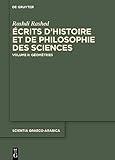Écrits d’histoire et de philosophie des sciences. Volume II, Géométries / Roshdi Rashed.
Material type: TextSeries: Scientia Graeco-Arabica ; 36/2Publisher: Berlin ; Boston : De Gruyter, [2023]Copyright date: ©2023Description: 1 online resource (XVI, 644 p.)Content type:
TextSeries: Scientia Graeco-Arabica ; 36/2Publisher: Berlin ; Boston : De Gruyter, [2023]Copyright date: ©2023Description: 1 online resource (XVI, 644 p.)Content type: - 9783110784626
- 9783110784763
- online - DeGruyter
- Issued also in print.
| Item type | Current library | Call number | URL | Status | Notes | Barcode | |
|---|---|---|---|---|---|---|---|
 eBook
eBook
|
Biblioteca "Angelicum" Pont. Univ. S.Tommaso d'Aquino Nuvola online | online - DeGruyter (Browse shelf(Opens below)) | Online access | Not for loan (Accesso limitato) | Accesso per gli utenti autorizzati / Access for authorized users | (dgr)9783110784763 |
Browsing Biblioteca "Angelicum" Pont. Univ. S.Tommaso d'Aquino shelves, Shelving location: Nuvola online Close shelf browser (Hides shelf browser)
Frontmatter -- AVANT-PROPOS -- TABLE DES MATIÈRES -- AL-KINDĪ’S COMMENTARY ON ARCHIMEDES’ ‘THE MEASUREMENT OF THE CIRCLE’ -- IBN SAHL ET AL-QŪHĪ : DIOPTRIQUE ET MÉTHODES PROJECTIVES AU Xe SIÈCLE -- IBN SAHL ET AL-QŪHĪ: LES PROJECTIONS ADDENDA & CORRIGENDA -- ARCHIMEDEAN LEARNING IN THE MIDDLE AGES: THE BANŪ MŪSĀ -- THĀBIT IBN QURRA -- LA GÉOMÉTRIE DE DESCARTES ET LA DISTINCTION ENTRE COURBES GÉOMÉTRIQUES ET COURBES MÉCANIQUES -- AL-QŪHĪ ET AL-SIJZĪ: SUR LE COMPAS PARFAIT ET LE TRACÉ CONTINU DES SECTIONS CONIQUES -- LES MATHÉMATIQUES DE LA TERRE -- LA CLASSIFICATION DES COURBES: GEMINUS ET AL-SIJZĪ -- THĀBIT IBN QURRA ET LA THÉORIE DES PARALLÈLES -- LA MODERNITÉ MATHÉMATIQUE : DESCARTES ET FERMAT -- LES PREMIÈRES CLASSIFICATIONS DES COURBES -- LES OVALES DE DESCARTES -- ARABIC VERSIONS AND REEDITING APOLLONIUS’ CONICS -- LIRE LES ANCIENS TEXTES MATHÉMATIQUES : LE CINQUIÈME LIVRE DES CONIQUES D’APOLLONIUS -- LE CONCEPT DE TANGENTE DANS LES CONIQUES D’APOLLONIUS -- LES CONSTRUCTIONS GÉOMÉTRIQUES ENTRE GÉOMÉTRIE ET ALGÈBRE : L’ÉPÎTRE D’ABŪ AL-JŪD À AL-BĪRŪNĪ -- SUR UN THÉORÈME DE GÉOMÉTRIE SPHÉRIQUE : THÉODOSE, MÉNÉLAÜS, IBN ʿIRĀQ ET IBN HŪD -- QU’EST-CE QUE LES CONIQUES D’APOLLONIUS? -- ON MENELAUS’ SPHERICS III.5 IN ARABIC MATHEMATICS, I: IBN ʿIRĀQ ABSTRACT -- ON MENELAUS’ SPHERICS III.5 IN ARABIC MATHEMATICS, II: NAṢĪR AL-DĪN AL-ṬŪSĪ AND IBN ABĪ JARRĀDA -- Abū Naṣr ibn ʿIrāq: ʿindamā kāna al-Amīr āliman (When the Prince was a scientist), al-Tafahom , 40, 2013,
restricted access online access with authorization star
http://purl.org/coar/access_right/c_16ec
Les textes réunis dans ces quatre volumes portent sur l’histoire et la philosophie des mathématiques et de leurs applications. Les trois premiers tomes sont consacrés à l’histoire des mathématiques (arithmétique, algèbre, géométrie), de l’optique et de l’astronomie, de l’Antiquité à l’Âge classique. Les très nombreuses études qu’ils contiennent ont renouvelé, au cours des cinquante dernières années, l’étude des principaux mathématiciens grecs – Euclide, Archimède, Apollonius, Diophante, Ménélaüs – et ont montré quelle a été la nature et la portée de leur réception et de leurs transformations, tant dans l’Islam classique qu’au cours de la première modernité européenne. Le quatrième volume fonde et explore divers champs de recherche entre philosophie et mathématiques, des interactions polymorphes propres à la science grecque, arabe et latine jusqu’à la mathématisation des sciences sociales au XVIIIe siècle. Tant par la nouveauté des matériaux découverts et édités pour la première fois que par la puissance et la finesse qui en guident toujours l’analyse épistémologique, les dizaines de contributions ici rassemblées représentent une œuvre majeure, qui a changé l’histoire des sciences de notre temps.
The texts in these four volumes deal with the history and philosophy of mathematics and its applications. The first three volumes are devoted to the history of mathematics (arithmetic, algebra, geometry), optics and astronomy, from Antiquity to the Classical Age. Over the last fifty years, the numerous studies contained in this volume have renewed the study of the main Greek mathematicians - Euclid, Archimedes, Apollonius, Diophantus, Menelaus - and have shown the nature and scope of their reception and transformations, both in classical Islam and in early European modernity. The fourth volume establishes and explores various fields of research between philosophy and mathematics, from the polymorphous interactions specific to Greek, Arab and Latin science to the mathematisation of the social sciences in the eighteenth century. Both in terms of the novelty of the material discovered and published for the first time and the power and finesse that continue to guide its epistemological analysis, the dozens of contributions collected here represent a major work that has changed the history of science in our time.
Issued also in print.
Mode of access: Internet via World Wide Web.
In French.
Description based on online resource; title from PDF title page (publisher's Web site, viewed 26. Apr 2024)









